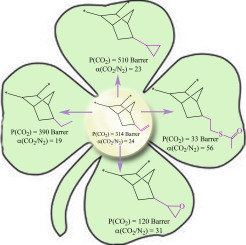Reactive & Functional Polymers ( IF 4.5 ) Pub Date : 2020-01-30 , DOI: 10.1016/j.reactfunctpolym.2020.104513 Alyona I. Wozniak , Evgeniya V. Bermesheva , Fedor A. Andreyanov , Ilya L. Borisov , Danil P. Zarezin , Danila S. Bakhtin , Natalia N. Gavrilova , Igor R. Ilyasov , Mikhail S. Nechaev , Andrey F. Asachenko , Maxim A. Topchiy , Alexey V. Volkov , Eugene Sh. Finkelshtein , Xiang-Kui Ren , Maxim V. Bermeshev

|
Herein four modified polymers were prepared from readily available addition poly(5-vinyl-2-norbornene) (PVNB) and their gas-transport properties were studied in detail. Hydrogenation, epoxidation, cyclopropanation and thiol-en reactions were chosen for the modifications of PVNB. Hydrogenation of PVNB was performed using p-toluenesulfonyl hydrazide. Epoxidation of PVNB was realized employing m-chloroperoxybenzoic acid. Cyclopropanation of PVNB was carried out using diazomethane in the presence of a Pd-catalyst. For thiol-en reaction, thioacetic acid was applied as the source of a thiol and AIBN as an initiator. All listed modifications were performed in high yields (≥80%) without the destruction of polymer main chains. The degree of functionalizations was up to 99%. The influence of these modifications on the properties of the resulting polymers was evaluated. Cyclopropanation and hydrogenation of PVNB led to an enhancement of gas permeability with minimal decrease in selectivity, while epoxidation or thioacetylation gave a substantial increase in CO2/N2 selectivity with decrease in permeability. The modified polymers with polar side-groups exhibited attractive selectivities for CO2/N2, CO2/CH4 and H2/N2 gas separations.
中文翻译:

聚(5-乙烯基-2-降冰片烯)的加成改性和所得聚合物的气体传输性能
本文中,由易于获得的加成聚(5-乙烯基-2-降冰片烯)(PVNB)制备了四种改性聚合物,并对其气体传输性能进行了详细研究。选择氢化,环氧化,环丙烷化和巯基反应来修饰PVNB。PVNB的氢化使用对甲苯磺酰肼进行。PVNB的环氧化反应实现使用米-氯过氧苯甲酸。PVNB的环丙烷化是在Pd催化剂存在下使用重氮甲烷进行的。对于硫醇-en反应,将硫代乙酸用作硫醇的来源,并将AIBN用作引发剂。所有列出的修饰均以高收率(≥80%)进行,而不会破坏聚合物主链。功能化程度高达99%。评估了这些改性对所得聚合物的性能的影响。PVNB的环丙烷化和氢化导致气体渗透率提高,而选择性降低最小,而环氧化或硫代乙酰化使CO 2 / N 2大大增加渗透率降低的选择性。具有极性侧基的改性聚合物对CO 2 / N 2,CO 2 / CH 4和H 2 / N 2气体分离显示出有吸引力的选择性。































 京公网安备 11010802027423号
京公网安备 11010802027423号